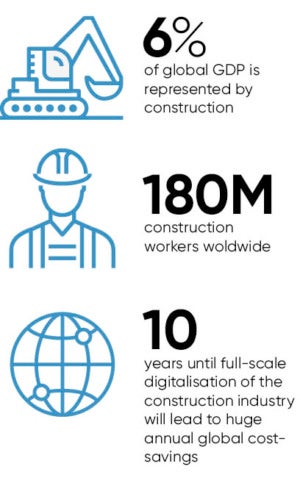 The global construction industry is faced with an intimidating challenge. How can it deliver a built environment that meets the aspirations of a growing, urbanising population, but do it in such a way that is economically viable, socially inclusive and environmentally sustainable?
The global construction industry is faced with an intimidating challenge. How can it deliver a built environment that meets the aspirations of a growing, urbanising population, but do it in such a way that is economically viable, socially inclusive and environmentally sustainable?
At the same time, technology is rapidly changing. While there is a rich heritage of technological change in construction, the pace is picking up so fast that it will completely transform the industry in a short period of time. Industry leaders need rapidly to understand and accommodate new technologies, such as infinite computing in the cloud, machine-learning, big data, robotics, drones, 3D printing, virtual reality and the internet of things (IoT).
Faced with such a rapid pace of change on these two fronts, the industry cannot keep pace by simply making modest tweaks to the way it does things.
Dominic Thasarathar, industry thought leader, construction, energy and natural resources at Autodesk, describes the pace of change and the opportunities it brings for the construction industry as “breathtaking”.
He says: “What is so exciting is the convergence of all these new technologies that is like nothing we have seen before. When you put them all together, it is going to transform totally the way we design and build, and the way we operate buildings, infrastructure and cities. The timing couldn’t be more pertinent given the task the industry faces over the next decade and a half.”
Cloud computing has given even the smallest contractors access to computer processing power that was unthinkable just a few years ago and until recently was out of reach for all but the biggest companies.
By adapting the new technologies, we will not only make the industry better, but deliver a better built environment
Connecting building information modelling (BIM) with the power of the cloud – what Autodesk calls Connected BIM – is allowing project teams to improve collaboration on projects and, via mobile communications and computing, remove the traditional barriers between the site and the office. Information is going to flow far more efficiently throughout project supply chains and across the life cycle of built assets.
Whereas the traditional design process has often been an exercise in compromise, limited by time, money, computing power and expertise, these constraints will be lifted by technology, using algorithms, which enable generative design to allow designers to explore almost limitless options, and machine-learning to guide better decisions. It will bring about a shift from today’s best-practical approach to one of “best possible tomorrow”.
Productivity in construction has lagged behind developments in other industries, but technology will enable huge improvements in how projects are selected, funded and delivered.
Digital technology will become part of the DNA of buildings and infrastructure, through sensors and systems linked by the IoT, allowing better use of BIM to make buildings more responsive to the needs of their owners and occupants.
“By adapting the new technologies, we will not only make the industry better, but deliver a better built environment,” says Mr Thasarathar.
Some of the technology is verging on science fiction and is in its infancy, such as using 3D printing to build bridges, but some, such as the connection of cloud computing with BIM for cloud-connected project delivery teams, is fast becoming part of everyday commercial life.
Autodesk makes software used to produce things, from smartphones and cars to skyscrapers and animated film characters. Mr Thasarathar says: “There is definitely a change going on and, because we span several industries, we can see a new industrial revolution taking place and cross-pollination as industries learn from each other.”
Exactly how quickly the foundations of construction will change is unclear, but the one certainty is that it will change. Industry professionals need to invest time to understand the new era of connection and how they can harness the opportunities it will bring.
For more information please visit www.autodesk.co.uk/campaigns/eoc-video-study or follow @autodesk_UK




